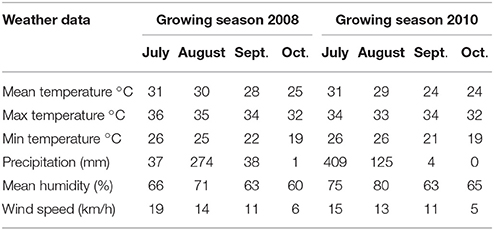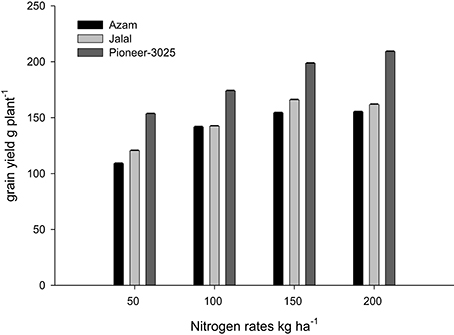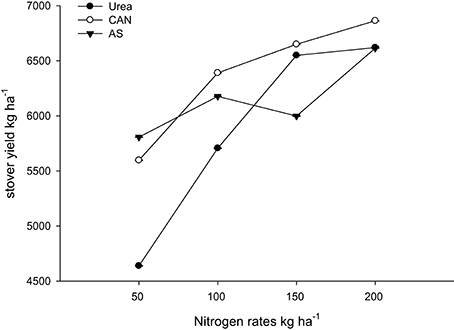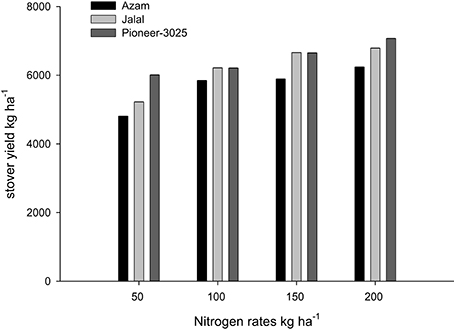- 1Department of Agronomy, Faculty of Crop Production Sciences, The University of Agriculture, Peshawar, Pakistan
- 2Crop Physiology and Production Center, College of Plant Science and Technology, Huazhong Agricultural University, Wuhan, China
- 3ICAR- Indian Institute of Rice Research, Soil Science, Hyderabad, India
Nitrogen is one of the most important factor affecting maize (Zea mays L.) yield and income of smallholders under semiarid climates. Field experiments were conducted to investigate the impact of different N-fertilizer sources [urea, calcium ammonium nitrate (CAN), and ammonium sulfate (AS)] and rates (50, 100, 150, and 200 kg ha−1) on umber of rows ear−1 (NOR ear−1), number of seeds row−1 (NOS row−1), number of seeds ear−1 (NOS ear−1), number of ears per 100 plants (NOEP 100 plants−1), grain yield plant−1, stover yield (kg ha−1), and shelling percentage (%) of maize genotypes “Local cultivars (Azam and Jalal) vs. hybrid (Pioneer-3025).” The experiment was conducted at the Agronomy Research Farm of the University of Agriculture Peshawar during summers of 2008 (year one) and 2010 (year two). The results revealed that the N treated (rest) plots (the average of all the experimental plots treated with N) had produced higher yield and yield components, and shelling percentage over N-control plots (plots where N was not applied). Application of nitrogen at the higher rate increased yield and yield components in maize (200 > 150 > 100 > 50 kg N ha−1). Application of AS and CAN had more beneficial impact on yield and yield components of maize as compared to urea (AS > CAN > urea). Hybrid maize (P-3025) produced significantly higher yield and yield components as well as higher shelling percentage than the two local cultivars (P-3025 > Jalal = Azam). Application of ammonium sulfate at the rate of 200 kg N ha−1 to hybrid maize was found most beneficial in terms of higher productivity and grower's income in the study area. For the two local cultivars, application of 150 kg N ha−1 was found more beneficial over 120 kg N ha−1 (recommended N rate) in terms of greater productivity and growers income.
Introduction
Maize (Zea mays L.) is the 2nd important crop after wheat in the Khyber Pakhtunkhwa Province of Pakistan. The yield of maize is very low (1868 kg ha−1) in Khyber Pakhtunkhwa (semiarid climate) than the average yield (3990 kg ha−1) in the country (Amanullah et al., 2009a,b; MINFAL, 2012). The reasons for low crop productivity in semiarid climate are: (1) low soil moisture availability (2) low soil fertility (Amanullah et al., 2012), and (3) indiscriminate use of chemical fertilizers by smallholders (Amanullah et al., 2015a). According to Oad et al. (2004) and Amanullah and Khan (2015), the major problems in the way of increasing yield at farmer's fields are the inappropriate nutrients supply. Among the plant nutrients, nitrogen (N) management is one of the most important factor required for improving crop productivity and profitability under semiarid climates (Amanullah, 2016). According to Guo et al. (2016), N is the most yield-restraining nutrient in crop production globally. Our previous research work on maize and nitrogen management revealed that proper nitrogen rates and nitrogen timings (splits) management improve maize growth and development (Amanullah et al., 2007, 2008, 2009a,b; Amanullah and Shah, 2010), yield and yield components (Amanullah et al., 2009a), grain quality (Amanullah et al., 2010), and growers income (Amanullah et al., 2010) in the study area. In another study (Amanullah et al., 2015b), we noticed that the integrated use of nitrogen (120 or 150 kg N ha−1) along with compost (2 t ha−1) improved yield and yield components in maize under deep (45 cm) than shallow (15 cm) tillage system under semiarid climate.
Increasing human population in Pakistan is resulting in less land for cultivation. Therefore, increase in crop productivity depends on higher yield per unit area. Increased cropping intensity especially under cereal based cropping system removes plant nutrients (Amanullah and Inamullah, 2016) from the soil, in addition to natural nitrogen losses (Gehl et al., 2005). Therefore, it has become of foremost importance to select high yielding varieties and genotypes that can uptake and utilize nitrogen more efficiently (Hirel et al., 2001). Efficient nitrogen fertilizer management is essential for achieving economic yields and for enhancing N use efficiency (Pan et al., 2012; Yousaf et al., 2014). Selection of high yielding cultivars is important for food security and growers incomes (Geiger, 2009). Best nitrogen management practices play an important role in increasing crop productivity (Fageria et al., 2006). Best nitrogen management practices minimize N losses and increases N availability for crops which increase nitrogen use efficiency and reduce negative impacts of N on the environment (Havlin et al., 2009). According to Amanullah (2014), N use efficiency (NUE) decrease with increase in N rate and the NUE was higher with application of ammonium sulfate (AS) over calcium ammonium nitrate (CAN) and urea. The hybrid maize had higher NUE than the local cultivars (Pioneer-3025 > Jalal > Azam). Ammonium sulfate increases NUE, however, its higher cost make it less profitable N-fertilizer for the maize growers in Northwest Pakistan (Amanullah et al., 2015a). The decline in the price of AS could make it more profitable and most suitable N-fertilizer source under semiarid climates in terms of higher NUE (Amanullah, 2014), higher net returns (Amanullah et al., 2015b), and better seed quality (Khan, 2016).
In the semiarid climates, growing maize hybrids are more efficient than local cultivars in terms of higher NUE and grower's income. However, no previous research was reported to investigate the response of different maize genotypes to different N sources × N levels interaction. This experiment was conducted with an overall objective to find the best level and best source of N fertilizer for improving yield and yield components of maize genotypes. Sustainable crop production relies on the continuous renewal of soil fertility through a balance between N demand and supply in cropping systems (Yousaf et al., 2016). Better management of high yielding crops with lower N loss is desperately needed to achieve sustainable agriculture (Duan et al., 2014). The current research project was therefore conducted to investigate yield and yield components response of maize genotypes [Pioneer-3025 (hybrid) in comparison with local cultivars (Jalal and Azam)] to N rates and sources to find out best N source and their level for higher maize productivity in the study area.
Materials and Methods
Site Description
“Field experiment was conducted at the Agronomy Research Farm of the University of Agriculture Peshawar for two years during summers of 2008 (year one) and 2010 (year two). The experimental farm is located at 34.01° N latitude, 71.35° E longitude at an altitude of 350 m above sea level in Peshawar valley. Peshawar is located about 1600 km north of the Indian Ocean and has continental type of climate. The research farm is irrigated by Warsak canal from river Kabul. Soil texture is clay loam, low in organic matter (0.87 %), extractable phosphorus (6.57 mg kg−1), exchangeable potassium (121 mg kg−1), and alkaline (pH 8.2) and is calcareous in nature (Amanullah et al., 2009a).” The climate of Peshawar is semiarid where the mean annual rainfall is very low (300–500 mm), 60–70% rainfall occurs in summer, while the remaining 30–40% rainfall occurs in winter (Amanullah et al., 2010a). Weather data for the maize growing periods in both years are given in Table 1.
Experimentation
“A field experiment was conducted in a randomized complete block design with split-plot arrangement using three replications. Factorial experimental treatments were four N rates [50, 100, 150, and 200 kg N ha−1] and three N-fertilizer sources (Urea having 46% N, Calcium Ammonium Nitrate having 26% N and 10% Ca, and Ammonium having 21% N and 24% S) used as main plots factor, while three maize genotypes (Jalal, Azam, and Pioneer-3025) were used as sub plots factor. One control plot (N not applied) was also used in each replication as check for comparison. A sub-plot size of 4.2 m by 5 m, having 6 rows, 5 m long, and 70 cm apart was used. A uniform basal dose of 60 kg P ha−1 as single super phosphate (18% P2O5), and 60 kg K ha−1 as sulfate of potash (50% K2O) was applied and mixed with the soil during seedbed preparation (Amanullah et al., 2015a).” Nitrogen in the form of urea, CAN, and AS was applied in two equal splits i.e., 50% at sowing and 50% at 2nd irrigation (30 days after emergence). “Data were recorded on number of rows ear−1, number of seed row−1, number of seed ear−1, number of ears 100 plants−1, grain yield, stover yield, and shelling percentage. Data on number of rows ear−1 was calculated by counting number of rows in ten selected ears and then it was averaged. Data on number of seed rows per ear was calculated by counting seed rows in ten selected ears and then it was averaged. Number of seeds ear−1 was calculated on ten randomly selected ears from each plot and then average was worked out. Data on number of ears 100 plants−1 was calculated by counting number of ears in 100 plants and then it was averaged (Amanullah and Khan, 2015).” Three central rows of each treatment was harvested the material was dried and converted into biological yield (kg ha−1). The ears of the three central rows were removed, threshed, grains were cleaned and weighted and then converted into grain yield (g plant−1). Stover was determined as the difference between biological minus grain yield, and shelling percentage each treatment was determined using the following formulae:
Statistical Analysis
Data were subjected to analysis of variance (see Table 2 for details) according to the methods described by Steel et al. (1997), and means between treatments was compared by least significant difference (P ≤ 0.05). The following model was used for the statistical analysis of data:
Where: Y, independent variable; u, overall mean; N, Nitrogen rates; S, Nitrogen sources; G, Genotypes; C v R, Control vs. Rest; E, random or pooled error.
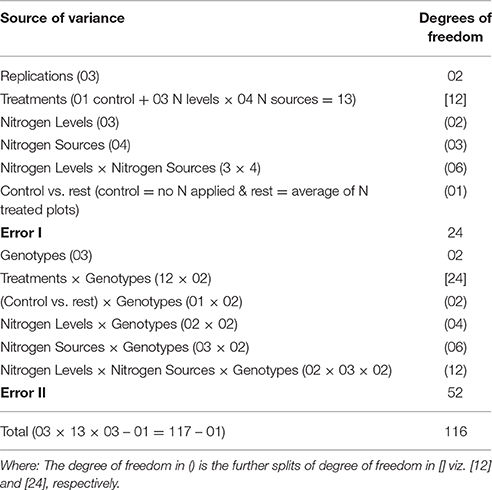
Table 2. Sample analysis of variance used for the statistical analysis of the data recorded in both years.
Results
It is clear from Table 3, that the rest (N treated plots) had produced number of rows ear−1 (NOR ear−1), number of seeds row−1 (NOS row−1), number of seeds ear−1 (NOS ear−1) than control plots (N not applied). In both the years, NOR ear−1, NOS row−1, and NOS ear−1 increased significantly (P ≤ 0.05) with application of N in two higher than the two lower rates. Application of AS (ammonium sulfate) produced more NOR ear−1 than urea and CAN (calcium ammonium nitrate). On the other hand, application of CAN produced more NOS row−1 and NOS ear−1 as compared to urea (Table 3). The hybrid maize had produced higher NOR ear−1, NOS row−1, and NOS ear−1 than the two local cultivars in both the years (Table 3). Increase in N level produced more NOR ear−1 and the increase was more in the maize hybrid than the two local cultivars that resulting in significant N-level × genotypes (N × G) interaction (Figure 1). Interaction of nitrogen source and nitrogen rates (N × S) in year one (Figure 2A) and year two (Figure 2B) indicating that the increase in N level had increased number of seeds per row while using different N sources. Interaction of N source and genotypes (S × G) indicated that in both years i.e., year one and two (Figures 3A,B, respectively), maize hybrid performed better by producing more number of seeds per row with each N source as compared with the two local maize cultivars. Interaction of N source and rates (N × S) had significant effects on NOS ear−1 (Figure 4), indicating that the NOS ear−1 increased to maximum with CAN applied at the rate of 150 kg N ha−1. While in case of urea the NOS ear−1 increased to maximum with the highest rate of 200 kg N ha−1 (Figure 4). Application of AS at the rate of 150 kg N ha−1 increased NOS ear−1 in both years. The NOS ear−1 increased to maximum in hybrid maize with application of CAN as compared to other N sources resulting in significant S × G interaction (Figure 5). The interaction between N rates and genotypes (N × G) indicated that NOS ear−1 increased in hybrid maize at all four levels of N and increased to maximum at the highest rate of 200 kg N ha−1 (Figure 6). On the other hand, the NOS ear−1 in the local cultivars increased up to 150 kg N ha−1 and further increase in N level had not significantly increased NOS ear−1.
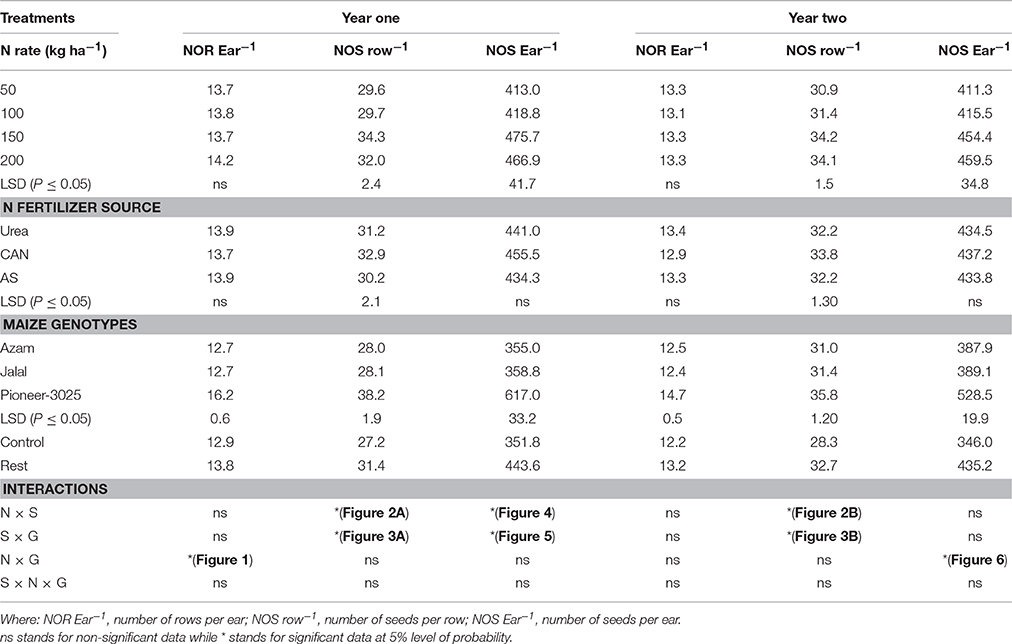
Table 3. Control (N not applied) vs. rest (all N applied plots), N rate, N source and genotypes influence on NOR Ear−1, NOS row−1, and NOS Ear−1of maize (mean effects).
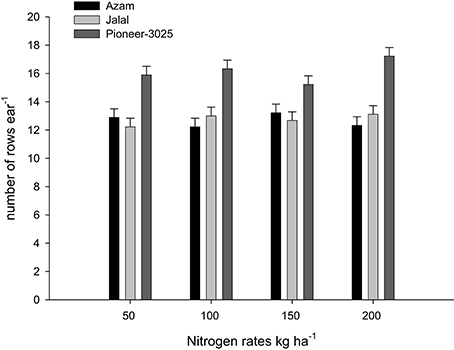
Figure 1. Nitrogen rates and genotypes interaction influence number of rows ear−1 in maize during 2008.
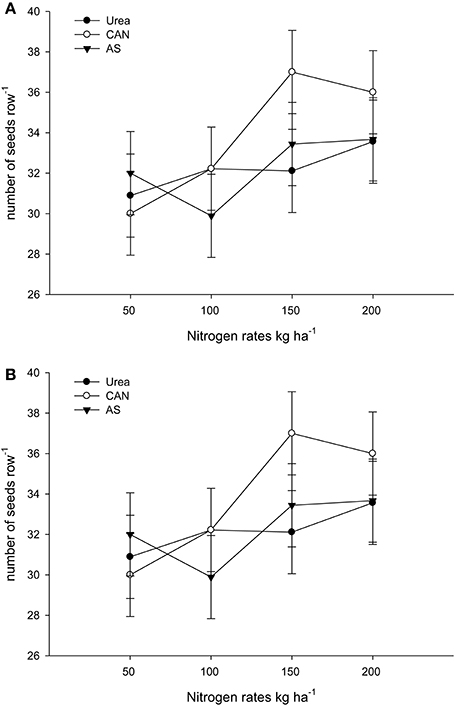
Figure 2. (A) Nitrogen rates and sources interaction influence number of seeds row−1 in maize during 2008. (B) Nitrogen rates and sources interaction influence number of seeds row−1 in maize during 2010.
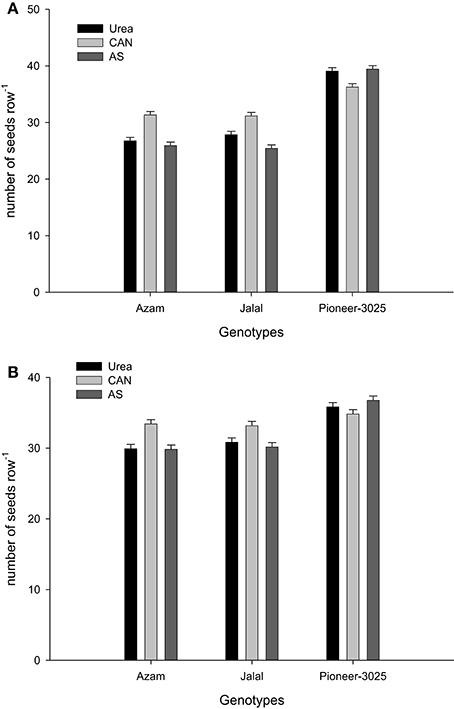
Figure 3. (A) Nitrogen sources and genotypes interaction influence number of seeds row−1 in maize during 2008. (B) Nitrogen sources and genotypes interaction influence number of seeds row−1 in maize during 2010.
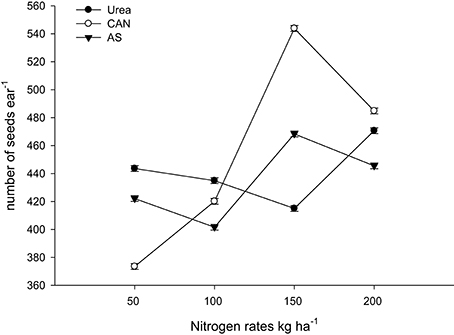
Figure 4. Nitrogen rates and sources interaction influence number of seeds ear−1 in maize during 2008.
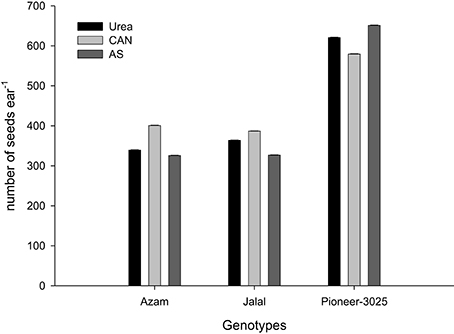
Figure 5. Nitrogen sources and genotypes interaction influence number of seeds ear−1 in maize during 2008.
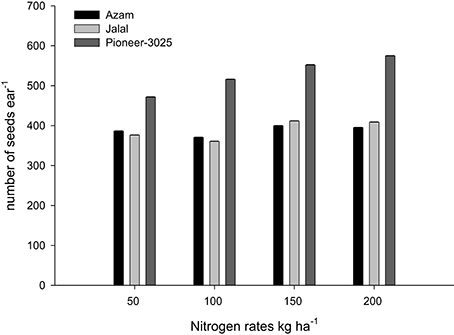
Figure 6. Nitrogen rates and genotypes interaction influence number of seeds ear−1 in maize during 2010.
Likewise, it is clear from Table 4 that the N rest had produced more number of ears per 100 plants (NOEP 100 plants), grain yield, stover yield, and shelling percentage than the control plots. In both years NOEP 100 plants, grain and stover yields (Table 4) increased significantly with application of N in two higher than the two lower rates. The effect of nitrogen sources was not significant for NOEP 100 plants (Table 4). Ammonium sulfate treated plots produced higher grain yield, followed by CAN, while less grain yield was recorded from urea (Table 4). Application of CAN produced more stover yield, followed by AS, while less stover yield was recorded from urea treated plots. The hybrid maize had produced higher NOEP 100 plants, grain, and stover yields than the two local cultivars in the two years (Table 4). Interaction between N rates and genotypes (N × G) had significant effects on NOEP 100 plants (Figure 7). The NOEP 100 plants increased in maize hybrid while increasing N level up to 200 kg N ha−1, while in the local cultivars NOEP 100 plants increased up to 150 kg N ha−1 and further increase in N had no significant effect on NOEP 100 plants. Interaction between N rates and genotypes (N × G) had significant effects on grain yield in 2nd year (Figure 8). The grain yield increased in maize hybrid while increasing N rate as compared to the two local maize cultivars. The grain yield of the two cultivars increased with increase in N up to 150 kg N ha−1 and further increase in N rate 200 kg N ha−1 did not increased grain yield significantly. Interaction between N source and N rates (N × S) had significant effects on stover yield in the first year only (Figure 9). The stover yield increased with increase in N rates while using each N fertilizer source. Interaction between N rates and genotypes (N × G) indicated that stover yield increased in hybrid maize with increase in N level up to 200 kg N ha−1, while in the local cultivars stover yield increased up to 150 kg N ha−1 and further increase in N up to 200 kg N ha−1 did not increased the stover yield significantly (Figure 10).
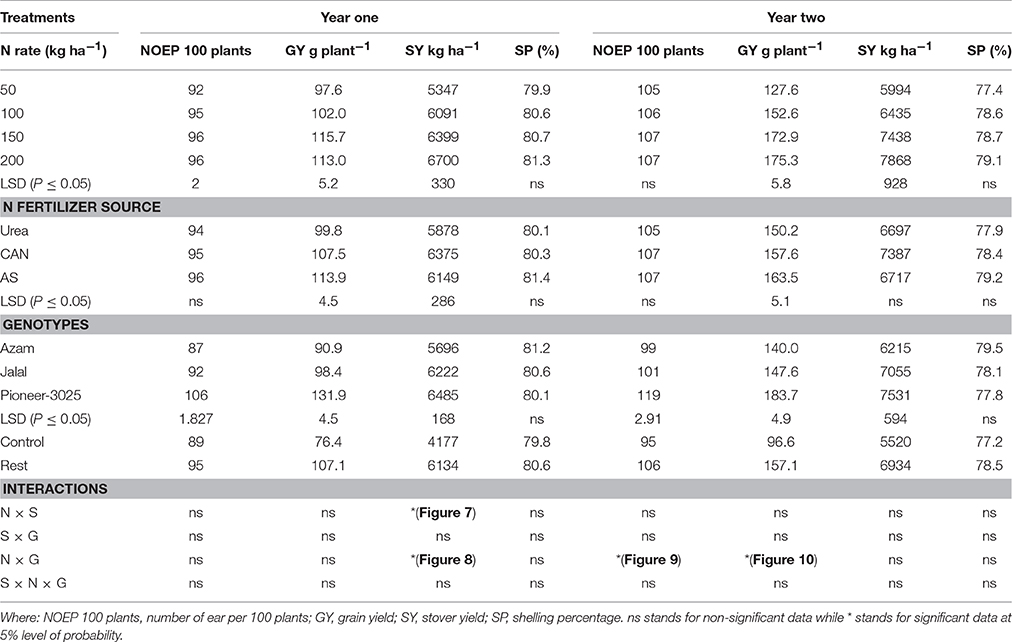
Table 4. Control (N not applied) vs. rest (all N applied plots), N rate, N source and genotypes influence on NOEP 100 plants, grain yield g plant−1, stover yield kg ha−1, and shelling percentage (%) of maize (mean effects).
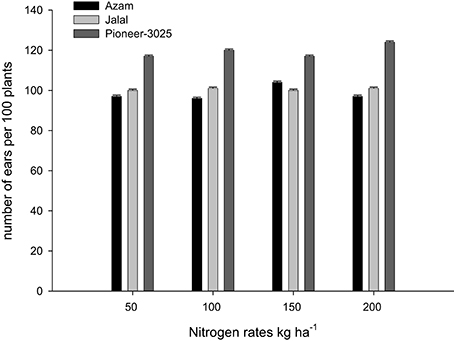
Figure 7. Nitrogen rates and genotypes interaction influence number of ears per 100 plants in maize during 2010.
Discussion
Nitrogen Rate
The higher in yield and yield components of maize under higher N rates over the lower N rates was attributed to the increase in leaf area index (LAI) and total dry matter (TDM) accumulation (Amanullah et al., 2014), increase in NUE and harvest index (Amanullah, 2014). Hejazi and Soleymani (2014) reported that the N control treatment had the lowest yield components and grain yield than the N fertilized plots. Increase in yield components of maize in the N fertilized probably may be attributed to less competition among maize plants for nitrogen, and the plants therefore accumulated more biomass and partitioned more dry matter into the reproductive parts (ears) because of its higher LAI (Amanullah et al., 2014). The higher capacity of the plants to convert more photosynthates into the reproductive parts increases maize productivity. Increase in maize productivity with nitrogen fertilization was also reported by many workers (Malaiya et al., 2004; Amanullah et al., 2009a, 2015b). The increase in yield and yield components in the current study with N supply probably may be due to the increase in light interception (Amanullah et al., 2008) because of it higher LAI (Amanullah et al., 2014). Many researchers reported improvement in maize yield and yield components while increasing N level. For example, Malaiya et al. (2004) reported that N fertilizer treatments produced higher number of ears in maize crop. Zeidan et al. (2006) reported that grains number ear−1 in maize was maximum at the highest nitrogen rate. Alizade et al. (2007) reported increase in yield components with higher N level. Khatun et al. (2012) and Sampath et al. (2013) revealed that stover yield in maize increases with increasing N rate. According to Yousaf et al. (2016), for a sustainable crop production continuous renewal of soil fertility through a balance between N demand and supply in cropping systems is important. Guo et al. (2016) reported that N is the most yield-restraining nutrient in crop production globally.
Nitrogen Source
Yield and yield components in maize increased with application of either AS or CAN as compared with urea. The increase in yield and yield components with AS or CAN over urea may be attributed to the increase in LAI and total dry matter accumulation (Amanullah et al., 2014) and increase in N-use efficiency (Amanullah, 2014). According to the review of Chien et al. (2011), ammonium sulfate is the best N-fertilizer source which contains frees sulfur and had many potential agronomic and environmental benefits over urea and ammonium nitrate. However, because of its (AS) highest N cost than the N cost of other N sources (CAN and urea), the small landholder can't afford to use AS for crop production (Amanullah et al., 2014). The higher transportation charges of AS is also more than urea and CAN (Amanullah et al., 2014). On the other hand, the low hygro-scopicity of AS and as a source of both N (21%) and S (24%), and its strongly acid reaction in the soil is the advantage of AS on high pH soils especially on S-deficient soils in semiarid climate (Havlin et al., 2009). According to Sas (2006), CAN is an important N-fertilizer source for neutralizing soil acidity. Amanullah et al. (2013) found significant differences among the three N-sources (Urea, CAN, and AS) when these fertilizers were applied in the form of foliar spray. According to Fageria et al. (2011), the higher and lower N rate in the form of AS increase yield, while the intermediate N rates (125–275 mg N kg−1) in the form of urea was better than AS.
Genotypes
The supremacy of hybrid maize in terms of higher productivity over the two local cultivars was attributed to the higher LAI and total dry matter accumulated by the hybrid maize than the local cultivars (Amanullah et al., 2014). Moreover, the higher NUE of hybrid maize (Amanullah, 2014) could also be the possible cause of higher yield and yield components produced by the maize hybrid over the two local cultivars. Hokmalipour et al. (2010) reported significant variation in N use efficiency, productivity and growers income among various maize cultivars. Many other workers (e.g., Akram et al., 2010; Sampath et al., 2013; Hejazi and Soleymani, 2014; Sani et al., 2014) reported variations in yield and yield components among different maize cultivars. Cui et al. (2009) reported that the interaction between genotypes and nitrogen significantly influence grain yield and NUE in maize.
Conclusions
Nitrogen management is one of the most important factor for improving crop productivity under semiarid climates. The results of this study confirmed the existence of significant variability in yield and yield components of maize depending on genotypes inheritance, differences in N fertilizer source and rates as well as differences in the weather condition. Application of nitrogen at the rate of 150 and 200 kg N ha−1 in the form of urea, 100 and 150 kg N ha−1 in the form of CAN (calcium ammonium nitrate) and 50 and 100 kg N ha−1 in the form of ammonium sulfate was more beneficial for improving maize productivity in the study area. The current higher price of fertilizers along and the less purchasing power had negative impact on smallholder's income. The superiority of AS over urea probably may be due to the presence of sulfur (24%) which is lacking in urea. Ammonium sulfate has an acidifying effect on soil, therefore, its continuous use may be advantageous on alkaline soils especially under arid and semiarid climates. The superiority of CAN over urea may be attributed to the availability of N in the two different forms (ammonium and nitrate) which make the N availability for long time than urea. Decrease in the cost of hybrid seeds and N-fertilizers especially ammonium sulfate will decrease production cost and could increase crop productivity, profitability and sustainability under semiarid climates.
Author Contributions
Amanullah designed the research project, analyzed the data, and wrote the manuscript. AI and AA performed the experiments, collected the data, made tables and figures. SF and BP helped in the editing of the manuscript.
Funding
This research was supported by The University of Agriculture Peshawar from its endowment fund.
Conflict of Interest Statement
The authors declare that the research was conducted in the absence of any commercial or financial relationships that could be construed as a potential conflict of interest.
References
Akram, M., Ashraf, M. Y., Waraich, E. A., Hussain, M., Hussain, N., and Mallahi, A. R. (2010). Performance of autumn planted maize (Zea mays L.) hybrids at various nitrogen levels under salt affected soils. Soil Environ. 29, 23–32.
Alizade, O., Majidi, I., Nadian, H. A., and Mohamadi, G. H. N. (2007). Effect of drought stress and nitrogen rates on yield and yield components of corn. Int. J. Agric. Sci. 13, 427–437. doi: 10.4172/2329-9029.1000164
Amanullah (2014). Source and rate of nitrogen application influence agronomic N-use efficiency and harvest index in maize (Zea mays L) genotypes. Maydica 59, 80–89.
Amanullah (2016). Rate and timing of nitrogen application influence partial factor productivity and agronomic NUE of maize (Zea mays L) planted at low and high densities on calcareous soil in northwest Pakistan. J. Plant Nutr. 39, 683–690. doi: 10.1080/01904167.2015.1087031
Amanullah, Almas, L. K., and Al-Noaim, N. I. (2015a). Nitrogen Rates and Sources Affect Yield and Profitability of Maize in Pakistan. Peshawar: Crop, Forage & Turfgrass Management.
Amanullah and Shah, P. (2010). Timing and rate of nitrogen application influence grain quality and yield in maize planted at high and low densities. J. Sci. Food Agric. 15, 21–29.
Amanullah, Asif, M., and Almas, L. K. (2012). Agronomic efficiency and profitability of P-fertilizers applied at different planting densities of maize in northwest Pakistan. J. Plant Nutr. 35, 331–341. doi: 10.1080/01904167.2012.639916
Amanullah, Hassan, M. J., Nawab, K., and Ali, A. (2007). Response of SLA, LAI and LAR of Maize as affected by plant density, rate and timing of nitrogen application. World Appl. Sci. J. 2, 235–243.
Amanullah and Inamullah (2016). Residual phosphorus and zinc influence wheat productivity under rice–wheat cropping system. Springerplus 5:255. doi: 10.1186/s40064-016-1907-0
Amanullah Khan, A. (2015). Phosphorus and compost management influence maize (Zea mays) productivity under semiarid condition with and without phosphate solubilizing bacteria. Front. Plant Sci. 6:1083. doi: 10.3389/fpls.2015.01083
Amanullah, Khan, A. Z., Jan, A., and Shah, Z. (2013). Foliar application of nitrogen at different growth stages influences the phenology, growth and yield of maize (Zea mays L.). Soil Environ. 32, 135–140.
Amanullah, Khan, I., Jan, A., Jan, M. T., Khalil, S. K., Shah, Z., et al. (2015b). Compost and nitrogen management influence productivity of spring maize (Zea mays L.) under deep and conventional tillage systems in Semi-arid regions. Commun. Soil Sci. Plant Anal. 46, 1566–1578. doi: 10.1080/00103624.2015.1043462
Amanullah, Khattak, R. A., and Khalil, S. K. (2009a). Effects of plant density and N on phenology and yield of maize. J. Plant Nutr. 32, 245–259.
Amanullah, Marwat, K. B., and Shah, P. (2009b). Nitrogen levels and its time of application influence leaf area, height and biomass of maize planted at low and high density. Pak. J. Bot. 41, 761–768.
Amanullah, Rahman, H., Shah, Z., and Shah, P. (2008). Effects of plant density and N on growth dynamics, light interception and yield of maize. Arch. Agron. Soil Sci. 54, 401–411. doi: 10.1080/03650340801998623
Amanullah, Shah, S., Shah, Z., Khalail, S. K., Jan, A., Jan, M. T., et al. (2014). Effects of variable nitrogen source and rate on leaf area index and total dry matter accumulation in maize (Zea mays L.) genotypes under calcareous soils. Turk. J. Field Crops. 19, 276–284. doi: 10.17557/tjfc.90307
Amanullah Yasir, M., Khan, A. Z., and Tariq Jan, M. (2010). Phenology, growth, and grain yield of maize as influenced by foliar applied urea at different growth stages. J. Plant Nutr. 33, 71–79. doi: 10.1080/01904160903391099
Chien, S. H., Gearhart, M. M., and Villagarcı, S. (2011). Comparison of ammonium sulfate with other nitrogen and sulfur fertilizers in increasing crop production and minimizing environmental impact: a review. Soil Sci. 176, 327–335. doi: 10.1097/SS.0b013e31821f0816
Cui, Z., Zhang, F., Mi, G., Chen, F., Li, F., Chen, X., et al. (2009). Interaction between genotypic difference and nitrogen management strategy in determining nitrogen use efficiency of summer maize. Plant Soil 317, 267–276. doi: 10.1007/s11104-008-9807-x
Duan, Y.-H., Shi, X.-J., Li, S.-L., Sun, X.-F., and He, X.-H. (2014). Nitrogen use efficiency as affected by phosphorus and potassiumin long-term rice and wheat experiments. J. Integr. Agric. 13, 588–596. doi: 10.1016/S2095-3119(13)60716-9
Fageria, N. K., Baligar, V. C., and Clark, R. B. (2006). Physiology of Crop Production. New York, NY: The Haworth Press.
Fageria, N. K., Moreira, A., and Coelho, A. M. (2011). Yield and yield components of upland rice as influenced by nitrogen sources. J. Plant Nutr. 34, 361–370. doi: 10.1080/01904167.2011.536878
Gehl, R. J., Schmidt, J. P., Maddux, L. D., and Gordon, W. B. (2005). Corn yield response to nitrogen rate and timing in sandy irrigated soils. Agron. J. 97, 1230–1238. doi: 10.2134/agronj2004.0303
Geiger, H. H. (2009). “Doubled haploids,” in Maize Handbook, Vol. II, Genetics and Genomics, eds J. L. Bennetzen and S. Hake (Heidelberg; New York, NY: Springer Verlag), 641–659. doi: 10.1007/978-0-387-77863-1_32
Guo, C., Li, P., Lu, J., Ren, T., Cong, R., and Li, X. (2016). Application of controlled release urea in rice: reducing environmental risk while increasing grain yield and improving nitrogen use efficiency. Commun. Soil Sci. Plant Anal. 47, 1176–1183. doi: 10.1080/00103624.2016.1166235
Havlin, J. H., Beaton, J. D., Tisdale, S. L., and Nelson, W. L. (2009). Soil Fertility and Fertilizers, 7th Edn. New Delhi: PHI Learning, Private Limited.
Hejazi, L., and Soleymani, A. (2014). Effect of different amounts of nitrogen fertilizer on grain yield of forage corn cultivars in Isfahan. Intl. J. Adv. Biol. Biom. Res. 2, 608–614.
Hirel, B., Bertin, P., Quiller9, I., Bourdoncle, W., Attagnant, C., Dellay, C., et al. (2001). Towards a better understanding of the genetic and physiological basis for nitrogen use efficiency in maize. Plant Physiol. 125, 1258–1270. doi: 10.1104/pp.125.3.1258
Hokmalipour, S., Janagard, M. S., Darbandi, M. H., Ashenaee, F. P., Hasanzadeh, M., Seiedi, M. S., et al. (2010). Comparison of agronomical nitrogen use efficiency in three cultivars of corn as affected by nitrogen fertilizer levels. World Appl. Sci. J. 8, 1168–1174.
Khan, A. (2016). Maize (Zea mays L.) genotypes differ in phenology, seed weight and quality (protein and oil contents) when applied with variable rates and source of nitrogen. J. Plant Biochem. Physiol. 4:164. doi: 10.4172/2329-9029.1000164
Khatun, H. A., Hasan, M. M., Sultana, S., Khatun, M., Rahman, S. M. E., and Oh, D. H. (2012). Effect of irrigation and nitrogen levels on the growth and yield of maize. Biol. Biomed. Rep. 2, 87–93.
Malaiya, S., Tripathi, R. S., and Shrivastava, G. K. (2004). Effect of variety, sowing time and integrated nutrient management on growth, yield attributes and yield of summer maize. Ann. Agri. Res. 25, 155–158.
MINFAL (2012). Agricultural Statistics of Pakistan. Govt. of Pakistan. Ministry of Food Agri. Livestock, Food Agricultural and Livestock, Division, Economic Wing, Islamabad, Pakistan.
Oad, F. C., Buriro, U. A., and Agha, S. K. (2004). Effect of organic and inorganic fertilizer application on maize fodder production. Asian J. Plant Sci. 3, 375–377. doi: 10.3923/ajps.2004.375.377
Pan, S.-G., Huang, S.-Q., Jing, Z., Wang, J.-P., Cao, C.-G., Cai, M.-L., et al. (2012). Effects of N management on yield and N uptake of rice in central China. J. Integr. Agric. 11, 1993–2000. doi: 10.1016/S2095-3119(12)60456-0
Sampath, O., Madhavi, M., and Rao, P. C. (2013). Evaluation of genotypes and nitrogen levels for yield maximization in rabi maize (Zea mays L.). Int. J. Innov. Res. Dev. 2, 314–318.
Sani, B. M., Abubakar, I. U., Falaki, A. M., Mani, H., and Jaliya, M. M. (2014). Grain yield and yield components of quality protein maize genotypes as influenced by irrigation and plant population in the nigerian savannah. J. Agric. Sci. 6, 166–172. doi: 10.5539/jas.v6n4p166
Sas, K. M. (2006). Effects of different N sources on growth and yield of sweet potato in the tropics. Fertilizer Soil Ferti. Res. 6, 321–326.
Steel, R. G. D., Torrie, J. H., and Deekey, D. A. (1997). Principles and Procedures of Statistics: A Biometrical Approach, 3rd Edn. New York, NY: McGraw Hill Book Co. Inc.
Yousaf, M., Fahad, S., Shah, A. N., Shaaban, M., Khan, M. J., Sabiel, S. A. I., et al. (2014). The effect of nitrogen application rates and timings of first irrigation on wheat growth and yield. Int. J. Agric. Innovat. Res. 2, 645–653. doi: 10.3389/fpls.2016.01496
Keywords: Zea mays L., N levels, N source, yield components, shelling percentage, grain yield, genotypes
Citation: Amanullah, Iqbal A, Ali A, Fahad S and Parmar B (2016) Nitrogen Source and Rate Management Improve Maize Productivity of Smallholders under Semiarid Climates. Front. Plant Sci. 7:1773. doi: 10.3389/fpls.2016.01773
Received: 28 August 2016; Accepted: 10 November 2016;
Published: 30 November 2016.
Edited by:
Alpha Kamara, International Institute of Tropical Agriculture, NigeriaReviewed by:
Yong Liu, Hunan Plant Protection Institute, ChinaKenneth Francis Masuki, CIMMYT, Tanzania
Jairos Rurinda, International Plant Nutrition Institute, Zimbabwe
Copyright © 2016 Amanullah, Iqbal, Ali, Fahad and Parmar. This is an open-access article distributed under the terms of the Creative Commons Attribution License (CC BY). The use, distribution or reproduction in other forums is permitted, provided the original author(s) or licensor are credited and that the original publication in this journal is cited, in accordance with accepted academic practice. No use, distribution or reproduction is permitted which does not comply with these terms.
*Correspondence: Amanullah, amanullah@aup.edu.pk
 Amanullah
Amanullah Asif Iqbal1
Asif Iqbal1 Shah Fahad
Shah Fahad Brajendra Parmar
Brajendra Parmar